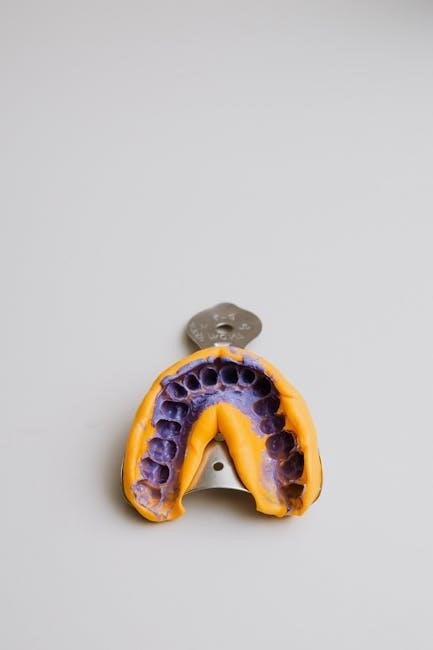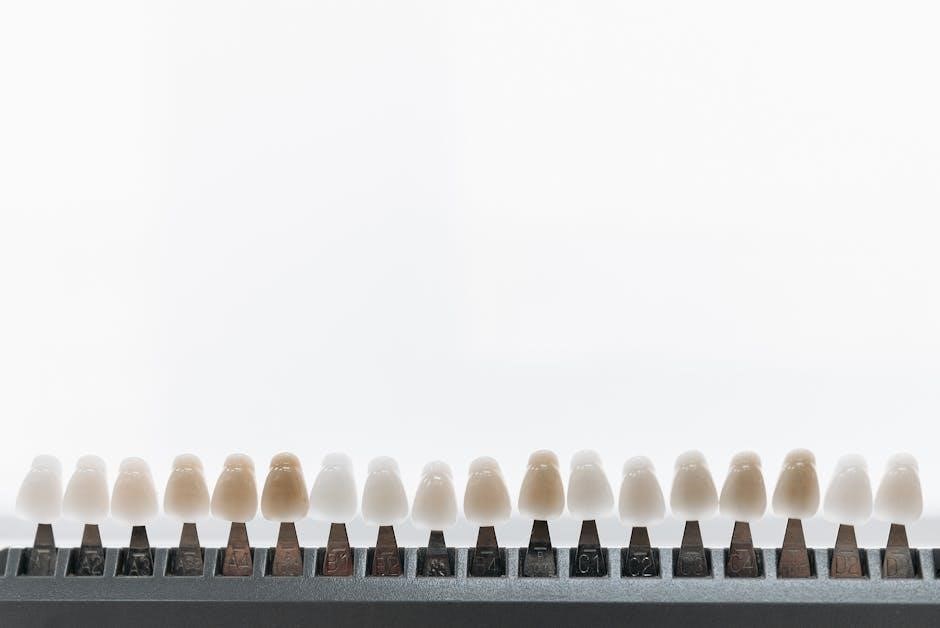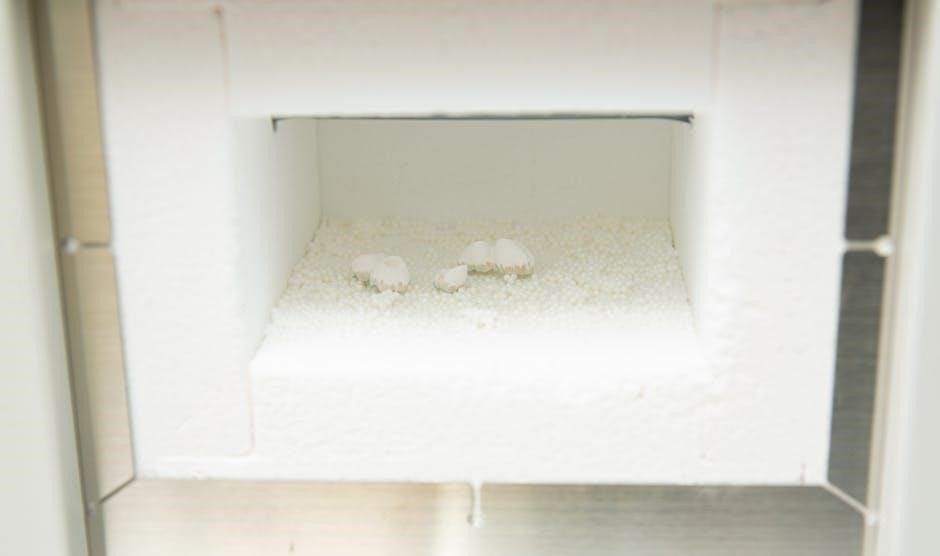The shape of denture teeth significantly impacts both aesthetics and functionality, influencing comfort, chewing efficiency, and overall satisfaction. Properly designed denture teeth align with facial contours, ensuring a natural appearance and optimal performance.
Overview of Denture Teeth Shape
Denture teeth shape plays a crucial role in restoring oral function and aesthetics. The shape is tailored to match facial contours, ensuring a natural appearance. Common shapes include ovoid, square, and tapered teeth, each suited for specific facial structures and bite requirements. Properly shaped denture teeth enhance chewing efficiency and speech clarity, while also boosting patient confidence. The selection process considers factors like mouth size, remaining natural teeth, and overall facial compatibility to achieve a harmonious and functional outcome.
Evolution of Denture Teeth Design
Denture teeth design has evolved significantly over the years, from rudimentary wooden and ivory teeth to modern, highly realistic options. Early designs focused on functionality, often sacrificing aesthetics. The introduction of vulcanite rubber in the 19th century improved durability, while acrylic resins later became the standard for natural appearance. Today, advancements in materials and digital technology enable customized shapes, colors, and alignment, prioritizing both comfort and a lifelike smile. This evolution reflects a shift from basic functionality to tailored, patient-centric solutions.
Factors Influencing Denture Teeth Shape
Facial structure, remaining natural teeth, mouth size, and denture compatibility are key factors shaping denture teeth design, ensuring a harmonious balance between aesthetics and functionality.
Facial Structure and Denture Compatibility
Facial structure plays a crucial role in determining denture teeth shape, ensuring compatibility and a natural appearance. The jawline, cheekbones, and facial symmetry guide the selection of tooth shapes, such as ovoid, square, or tapered, to harmonize with individual features. Proper alignment enhances both aesthetics and functionality, creating a balanced and lifelike smile that complements the patient’s overall facial contours.
Remaining Natural Teeth and Their Influence
The presence and condition of remaining natural teeth significantly influence the shape and design of denture teeth. They ensure proper occlusion, preventing uneven wear and misalignment. Natural teeth also guide the selection of denture teeth size and shape, maintaining a cohesive appearance and functionality. This harmonization is essential for both partial and complete dentures, ensuring comfort and a natural-looking smile that integrates seamlessly with existing teeth.
Mouth Size and Denture Teeth Proportions
Mouth size plays a crucial role in determining denture teeth proportions and their arrangement. For complete dentures, tooth size is often based on the arch length to ensure proper fit and aesthetics. In partial dentures, the space between remaining natural teeth dictates the proportions to prevent overcrowding and maintain alignment. Properly scaled teeth enhance both functionality and appearance, ensuring dentures look natural and function seamlessly within the patient’s oral environment.
Types of Denture Teeth Shapes
Denture teeth shapes vary, including ovoid, square, and tapered options, each designed for specific aesthetic and functional needs, ensuring natural appearance and optimal performance.
Ovoid Teeth: Characteristics and Use Cases
Ovoid teeth are characterized by their rounded shape and natural appearance, making them ideal for individuals with oval or round face shapes. They blend seamlessly with facial contours, enhancing aesthetics. These teeth are versatile and commonly used in both partial and complete dentures, offering a balance between comfort and functionality. Ovoid teeth are a popular choice for their ability to mimic the look of natural teeth, making them suitable for various dental restoration needs.
Square Teeth: Aesthetic and Functional Benefits
Square teeth are characterized by their straight edges and defined shape, often recommended for individuals with square or square-like facial features. They provide a strong, youthful appearance and can enhance facial symmetry. Functionally, square teeth are known for their durability and chewing efficiency, making them a practical choice. Their distinct shape allows for better distribution of chewing forces, contributing to overall dental function. This makes square teeth a popular option for those seeking both aesthetic appeal and functional performance.
Tapered Teeth: Advantages and Applications
Tapered teeth are characterized by their narrow, pointed shape, offering both aesthetic and functional benefits. They are ideal for individuals with smaller mouths or specific facial structures, providing a natural appearance. Tapered teeth enhance chewing efficiency and are often used in partial dentures where space is limited. Their streamlined design allows for better adaptation to surrounding tissues, making them a versatile choice for various dental needs. This shape is particularly advantageous for patients requiring precise alignment and optimal functionality.

Denture Teeth Selection Process
The selection process involves an initial consultation, assessment of facial structure, and digital imaging to tailor teeth shape to individual needs, ensuring optimal comfort and aesthetics.
Initial Consultation and Assessment
The initial consultation involves a thorough evaluation of the patient’s oral health, facial structure, and existing teeth. Dental professionals assess the jaw alignment, gum condition, and available space to determine the appropriate denture teeth shape. This step ensures a personalized fit, addressing aesthetic and functional needs. The consultation also discusses lifestyle factors and patient preferences, providing a clear roadmap for creating natural-looking, comfortable dentures.
Role of Digital Imaging in Tooth Selection
Digital imaging plays a crucial role in tooth selection by providing precise measurements and visual simulations. Advanced software creates 3D models of the patient’s mouth, allowing for accurate assessment of tooth shape, size, and alignment. This technology enhances the customization process, ensuring denture teeth blend seamlessly with the patient’s facial aesthetics and oral structure. Digital tools also facilitate real-time adjustments, improving both functional and aesthetic outcomes for a more natural-looking smile.
Aesthetics and Denture Teeth Shape
Aesthetics play a vital role in denture teeth shape, as they directly influence the natural appearance of the smile. Properly designed teeth enhance facial harmony and confidence.
Achieving a Natural Appearance
Achieving a natural appearance with denture teeth involves careful selection of shape, size, and color to match the patient’s facial features and remaining teeth. The goal is to create harmony between the denture teeth and the overall facial structure, ensuring a realistic and aesthetically pleasing smile. Advanced materials and customization options allow for personalized solutions, ensuring the denture teeth blend seamlessly with the patient’s natural look, enhancing confidence and overall satisfaction.
Color Variation for Realistic Look
Color variation in denture teeth enhances their natural appearance by mimicking the subtle shading and translucency of real teeth. Modern denture teeth are designed with layered color techniques, offering a range of shades to match individual preferences and skin tones. This customization ensures the denture teeth blend seamlessly with the surrounding oral environment, creating a lifelike smile that boosts confidence and satisfaction.
Dental Arch Compatibility
Dental arch compatibility ensures proper fit and functionality of denture teeth. The size and shape are tailored to the arch length, ensuring optimal alignment and comfort for both partial and complete dentures.
Maxillary and Mandibular Arch Considerations
The maxillary and mandibular arches play a crucial role in denture teeth shape selection. The maxillary arch, being larger, often requires teeth with a slightly rounded shape for better aesthetics and lip support. In contrast, the mandibular arch, smaller in size, may benefit from teeth with a tapered design to enhance stability and chewing efficiency. Proper alignment ensures balanced occlusion, while respecting the natural contours of both arches for optimal comfort and functionality.
Face Shape Correlation
Denture teeth shape is tailored to complement facial contours, ensuring a harmonious appearance. Ovoid, square, and tapered shapes align with specific face types for natural aesthetics and comfort.
Matching Denture Teeth to Facial Features
Denture teeth shape is carefully selected to match facial features, ensuring a natural and harmonious appearance. Rounded teeth complement oval or square faces, while tapered shapes suit triangular features. Dental professionals assess facial symmetry, jaw alignment, and lip contours to choose the most flattering options. This personalized approach enhances both aesthetics and comfort, creating a seamless integration of denture teeth with the patient’s unique facial structure for a confident and natural smile.
Material Options for Denture Teeth
Denture teeth are made from acrylic or ceramic materials. Acrylic teeth are cost-effective and lightweight, while ceramic teeth offer greater durability and a more natural appearance.
Acrylic vs. Ceramic Teeth: Pros and Cons
Acrylic teeth are cost-effective, lightweight, and easy to adjust, making them ideal for partial dentures. However, they are less durable and may wear down faster. Ceramic teeth, while more expensive, offer superior durability, stain resistance, and a natural appearance, making them suitable for full dentures. The choice depends on factors like budget, desired aesthetics, and longevity, with acrylic being a practical option and ceramic providing long-term satisfaction.

Trying On Denture Teeth
Temporary fittings allow patients to test denture teeth shape, ensuring comfort and aesthetics. Adjustments are made to achieve optimal fit and patient satisfaction.
Temporary Fittings and Adjustments
Temporary fittings enable patients to assess denture comfort and aesthetics. During trials, dentists evaluate fit, bite alignment, and overall appearance, making necessary adjustments for optimal results. Patients provide feedback to ensure satisfaction, and modifications are done to refine shape, color, and functionality. This iterative process ensures personalized fit and enhances the wearer’s confidence and comfort. Adjustments are crucial for achieving a natural look and proper function.
Lifestyle Considerations
Lifestyle factors, such as diet and oral hygiene habits, influence denture teeth shape selection. Choosing durable shapes and materials can enhance functionality and longevity, ensuring comfort and aesthetics.
Diet and Denture Teeth Shape
Diet plays a significant role in selecting denture teeth shapes, as certain foods require specific tooth forms for efficient chewing. Hard or crunchy foods, for example, may necessitate more durable shapes, such as square or tapered teeth, to withstand greater forces. Conversely, softer diets might allow for more rounded shapes, like ovoid teeth, for comfort and ease of use.
Understanding dietary habits helps in choosing teeth shapes that balance aesthetics, functionality, and long-term durability, ensuring optimal performance and patient satisfaction.
Maintenance of Denture Teeth
Regular cleaning with mild soap and water prevents stains and plaque buildup. Rinse after meals to remove food particles and soak overnight for hygiene and shape retention.
Cleaning and Care Tips
For optimal maintenance, clean denture teeth daily with mild soap and water. Use a soft-bristled toothbrush to gently remove plaque and food residue. Avoid harsh chemicals or abrasive cleaners, as they may damage the material. Rinse thoroughly after meals to prevent food particles from accumulating. Store dentures in a denture-cleaning solution overnight to maintain hygiene and shape. Regularly check for wear and tear, and visit your dentist for professional adjustments to ensure proper fit and functionality over time.

Cost of Denture Teeth
Denture teeth costs vary based on material quality, design complexity, and dental professional fees. Prices range widely, influenced by location and practitioner expertise.
Factors Affecting Pricing
The cost of denture teeth is influenced by material quality, with acrylic teeth being more affordable than ceramic ones. Design complexity, such as custom shapes or precision attachments, also increases expense. The expertise and location of the dental professional play a significant role, as do laboratory fees for custom fabrication. Additionally, patient-specific requirements, such as specialized features or advanced techniques, can elevate costs. Geographic demand and availability of materials further impact pricing, making it essential to consult a professional for accurate estimates.
Role of Dental Professionals
Dental professionals play a vital role in selecting and fitting denture teeth, ensuring they match facial features and provide optimal function and aesthetics.
Prosthetist’s Expertise in Tooth Selection
A prosthetist’s expertise is crucial in selecting denture teeth, ensuring they align with the patient’s facial structure and dental arch for a natural look. Their skills involve matching tooth shape to facial contours, considering factors like mouth size and remaining natural teeth. They use advanced techniques and materials to create custom solutions, enhancing both aesthetics and functionality. Proper tooth selection by a prosthetist ensures comfort and confidence for the patient;

Patient Satisfaction
Patient satisfaction hinges on proper fit and comfort, ensuring denture teeth align with facial contours for a natural appearance and enhanced confidence.
Importance of Proper Fit and Comfort
A proper fit ensures denture stability, preventing discomfort and irritation. Ill-fitting dentures can lead to poor retention, affecting chewing function and aesthetics. Comfort directly impacts patient satisfaction, as well-crafted denture teeth enhance confidence and quality of life. A natural appearance and seamless functionality are key to meeting patient expectations, making fit and comfort paramount in denture design.
Common Mistakes to Avoid
Common errors include selecting incorrect tooth shapes and neglecting facial structure compatibility. These mistakes can lead to poor aesthetics and functional issues, affecting overall satisfaction.
Incorrect Tooth Shape Selection
Choosing the wrong tooth shape can lead to poor aesthetics, discomfort, and functional issues. Teeth that don’t match facial contours may look unnatural, affecting self-confidence. Additionally, improper shapes can cause chewing difficulties and uneven distribution of biting forces, potentially harming oral health. Ensuring tooth shape aligns with facial features and dental arches is vital for optimal comfort and functionality.
Future Trends in Denture Teeth
Future trends emphasize customizable teeth using 3D printing and CAD technology for precise fits. Advanced materials like nanoceramics promise improved durability and realistic aesthetics, enhancing patient satisfaction.
Advancements in Materials and Design
Advancements in materials and design are revolutionizing denture teeth. 3D printing and CAD/CAM technology enable precise customization, offering tailored shapes and fits. New materials like nanoceramics and graphene-enhanced resins improve durability and aesthetics. These innovations allow for thinner, stronger teeth that mimic natural enamel, enhancing chewing efficiency and comfort. Biocompatible options reduce irritation, while digital workflows streamline production, ensuring faster turnaround times and higher patient satisfaction. These cutting-edge developments are setting new standards in denture aesthetics and functionality.

